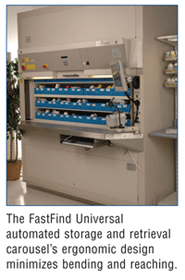US Pharm. 2010;35(2):HS-33-HS-34.
AmerisourceBergen and Franciscan Health System, a network of five hospitals and 650 beds that is headquartered in Tacoma, Washington, partnered to pilot a pharmaceutical supply chain model that would improve hospital pharmacy inventory management, storage, operational efficiency, and medication safety. Using AmerisourceBergen’s RxWorks Suite portfolio of technologies, including dispensing hardware and inventory management software, Franciscan was one of the first hospitals to implement a centralized pharmaceutical fill system in which one hospital receives and processes medication and manages inventory for the entire health system.

This hub-and-spoke fill model increases dispensing and administration safety, decreases inventory costs, and allows key pharmacy staff to be “on the floor” in the hospitals, focusing their efforts on important clinical and patient responsibilities. The health system is also close to fulfilling its goal of bedside, bar-coded medication administration and sees the hub-and-spoke model as the pharmacy distribution method of choice in the future.
The plan called for a total restructuring of Franciscan’s pharmaceutical supply chain process. The existing decentralized fill system, where each hospital received and processed its own medications, was replaced with a centralized fill hub-and-spoke model in which one location served the entire health system. St. Joseph, the largest hospital in the system, was designated as the “hub,” with all the other hospitals acting as “spokes.”
To launch the new model, Franciscan implemented AmerisourceBergen’s RxWorks Suite solution, which includes The FastPak EXP compliance packager with ClinicWorks pharmacy workflow software; FastFind Universal automated storage and retrieval carousels; SupplyWorks inventory management software; and bar-coding stations.
AmerisourceBergen packaged these technologies to streamline the hospital pharmacy medication supply chain process while ensuring that the new automation system would integrate with existing pharmacy hardware.
As one of the first hospitals to implement automation, Franciscan did encounter some initial resistance from pharmacy staff, but stuck to the vision and worked through the challenges. Now, everyone at Franciscan would agree that the struggles were well worth the payoff.
With the health system’s fill process now more than 95% centralized, Franciscan has a markedly safer and more efficient pharmaceutical supply chain process. The new FastFind storage and retrieval carousels have made locating medications easier and more efficient and have reduced the physical space each hospital needs for medication storage.
The medication replacement stock for more than 100 automated dispensing machines’ orders for the entire health system is filled each night by just one or two pharmacy technicians—a job that previously took several hours a day and involved many members of the pharmacy staff at each hospital. Additionally, the automated system has vastly improved inventory management. The health system estimates that in the short time the centralized model has been in effect, it has saved $50,000 in medication inventory costs, a figure it estimates will quickly climb to more than $250,000.
Franciscan has also increased medication safety that the hub-and-spoke model supports. Medication labels are now uniform, streamlined, and easy to read, which reduces the risk of medication errors. Every medication is now distributed with a unique barcode.






